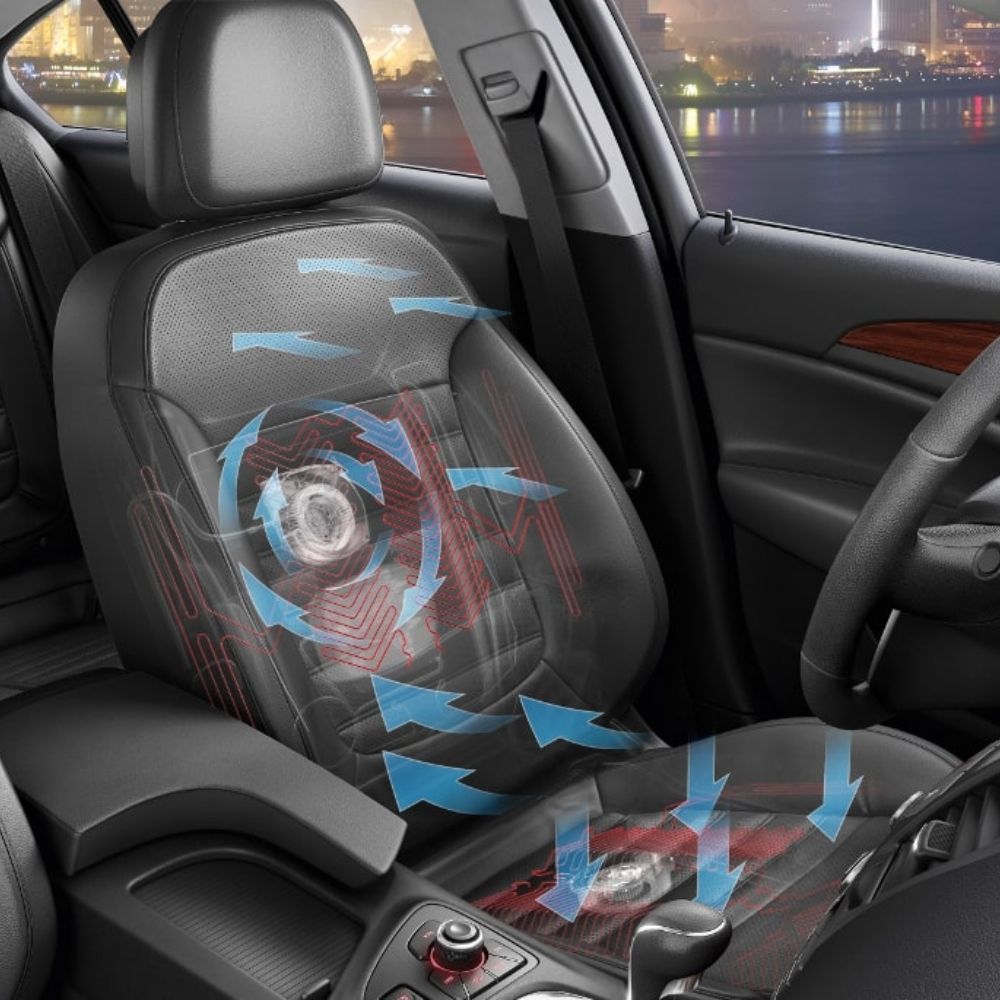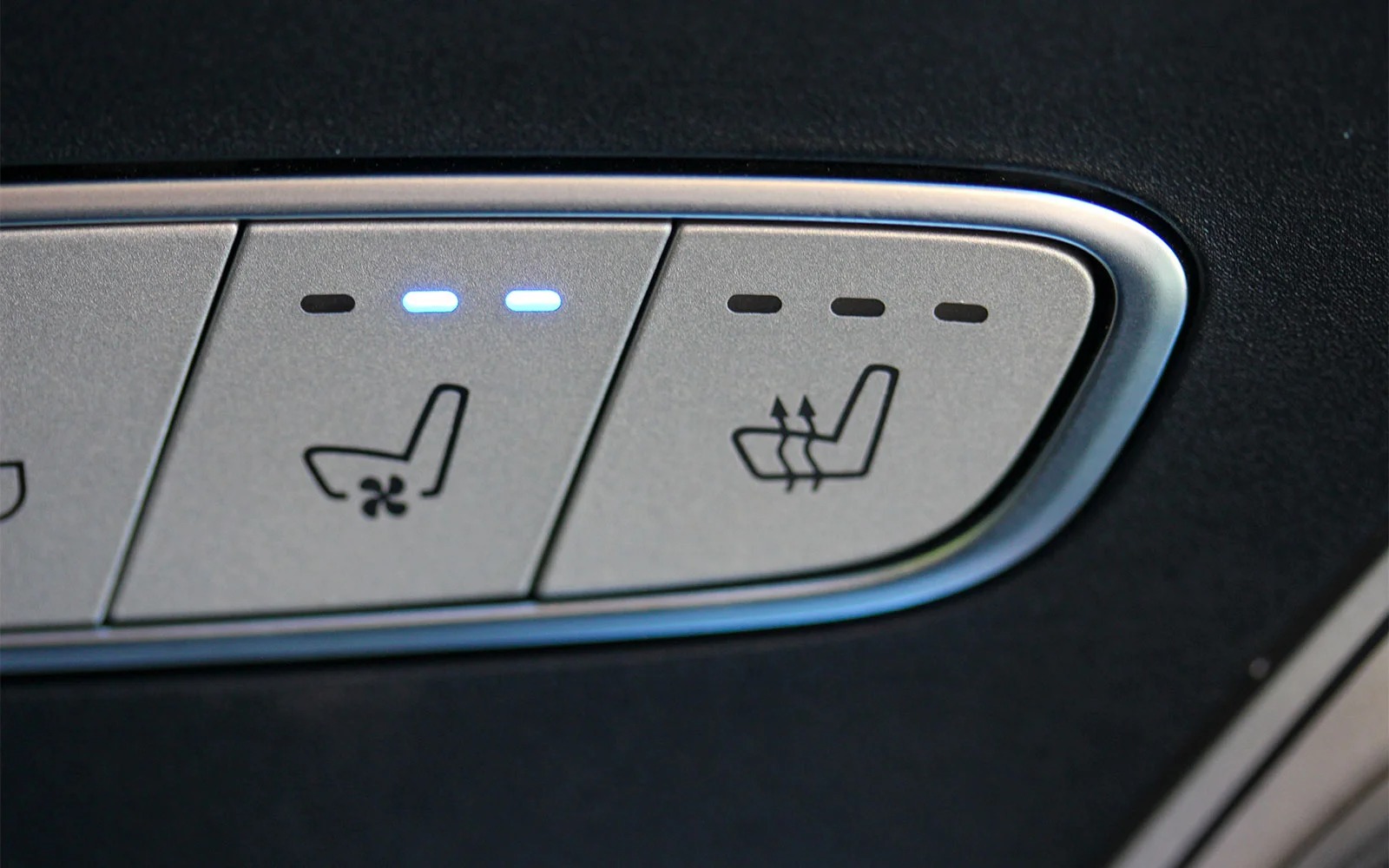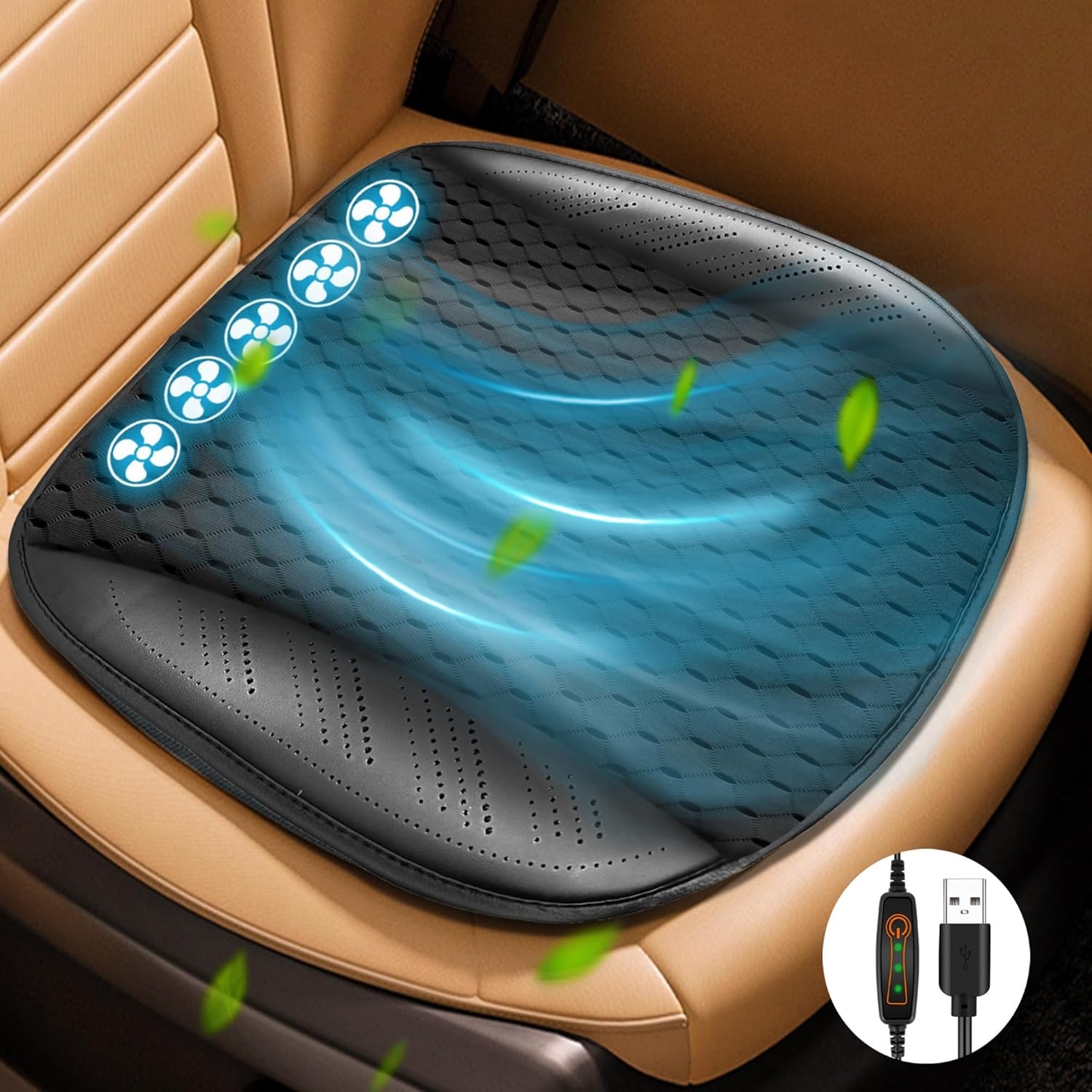

What are Ventilated Seats? How does Ventilated Seats work?
Contents
- What Are Ventilated Seats?
- Benefits of Ventilated Seats
- Enhanced Comfort in Hot Weather
- Better Air Circulation and Hygiene
- Reduces Fatigue on Long Drives
- Protects Upholstery from Heat Damage
- Works in Harmony with Air Conditioning
- Premium Feel and Resale Value
- How Does Seat Ventilation Work?
- How to Check if the Seats Are Ventilated?
- What Kind of Cars Have Ventilated Seats?
- Ventilated Seats – Is It Worth the Investment?
- Ventilated Seats vs. Cooled Seats: What’s the Difference?
Have you ever wondered what “ventilated seats” really mean in a car? Ventilated seats are an advanced comfort feature designed to keep drivers and passengers cool by circulating air through tiny perforations in the seat surface. Unlike traditional seats that trap heat, ventilated car seats use built-in fans or air channels to reduce sweating and discomfort, especially during long drives or in hot climates. In this article, we’ll explain what are ventilated seats, how ventilated seats work, and why they’ve become a must-have feature in modern vehicles.

What Are Ventilated Seats?
Ventilated seats are specially designed car seats equipped with a built-in air circulation system that helps keep the driver and passengers cool and comfortable. Instead of absorbing heat like traditional leather seats, ventilated seats allow air to flow through small perforations in the seat cushion and backrest.
This feature is particularly beneficial in warm climates, where interior temperatures can rise quickly. By moving air through the seat material, ventilated seats help reduce sweating, prevent discomfort during long drives, and maintain a pleasant body temperature.
Unlike heated seats, which warm the seat surface using electric elements, ventilated seats focus on air movement—either pulling hot air away from the body or blowing cool air through the seat. This makes them a premium comfort feature found in many modern and luxury vehicles.
In most modern vehicles, ventilated seats can be turned on directly from the car’s control system — either through dedicated buttons on the dashboard or via the infotainment screen. These controls often allow you to adjust fan speed and intensity based on your comfort preferences.
However, if your vehicle is a base model that doesn’t include this feature from the factory, it may still be possible to activate or retrofit ventilated seats through coding.
At AutoExplain, we provide Ventilated Seats Coding Service — enabling the activation of this function on compatible vehicles.
If you own a basic version and want to upgrade with this comfort feature, check out our detailed guide here: How to Activate Mercedes-Benz Ventilated Seats
Benefits of Ventilated Seats
Ventilated seats offer much more than just a touch of luxury — they significantly improve driving comfort and overall well-being, especially during long journeys or in hot climates. Below are the key advantages of having ventilated seats in your car:
Enhanced Comfort in Hot Weather
The most obvious benefit is comfort. By circulating air through the seat cushion and backrest, ventilated seats help prevent overheating and reduce the sticky feeling caused by sweat. This ensures a pleasant and relaxed driving experience, even during scorching summer days.
Better Air Circulation and Hygiene
Continuous airflow between your body and the seat surface helps minimize moisture buildup. This not only keeps you feeling fresh but also helps prevent unpleasant odors and bacterial growth, especially on leather or eco-leather upholstery.
Reduces Fatigue on Long Drives
When your body stays cool and dry, you’re less likely to feel tired or distracted. Ventilated seats help maintain alertness by keeping you comfortable, which is especially important for long-distance drivers and daily commuters.
Protects Upholstery from Heat Damage
Constant exposure to sunlight can heat up leather seats, causing cracks or fading over time. Ventilated seats help maintain a more stable temperature, indirectly extending the life of your car’s interior materials.
Works in Harmony with Air Conditioning
Ventilated seats complement the car’s A/C system by delivering cooling directly where it’s needed most — the driver and passengers. This allows the air conditioner to work more efficiently, potentially lowering overall energy consumption.
Premium Feel and Resale Value
As a comfort feature often associated with luxury vehicles, ventilated seats can make your car feel more upscale and even increase its resale appeal. Buyers today value features that enhance comfort and driving experience, making this a smart long-term investment.
How Does Seat Ventilation Work?
The working principle of ventilated seats is quite straightforward. These seats are designed with perforated upholstery—usually made from leather or synthetic materials—allowing air to pass through tiny holes in the seat cushion and backrest. Inside the seat, small electric fans powered by the vehicle’s electrical system circulate air through these perforations.
In most vehicles, the system draws in air from the cabin, typically from underneath the seat where the temperature tends to be lower. As a result, if the car does not have an air-conditioning system, the ventilation mainly provides air movement rather than active cooling. This airflow still helps create a fresher, drier, and more comfortable feeling, especially during long drives or in warm weather.
Some modern cars go beyond simple ventilation — they feature integrated cooling or heating systems, and in certain luxury models, even massage functions. Depending on the vehicle’s design and production year, the seat ventilation system can be controlled either through physical buttons on the seat or directly via the infotainment display.
Additionally, most ventilated seats offer multiple modes and intensity levels, allowing drivers and passengers to adjust airflow according to personal comfort and climate conditions.

How to Check if the Seats Are Ventilated?
The easiest way to identify ventilated seats is by looking at the upholstery. Ventilated car seats typically feature perforated leather or eco-leather surfaces with tiny holes across the seat cushion and backrest. However, it’s important to note that not every perforated seat is ventilated — the holes alone don’t guarantee that a ventilation system is installed.
True ventilated seats include a built-in fan system that circulates air through the seat. These fans are part of a more complex internal structure that also houses electronic controls, wiring, and sensors. Because of this added technology, ventilated seats require specialized internal materials designed to withstand vibration, heat, and pressure.
Modern ventilated seats often use expanded polypropylene (EPP) foam — a lightweight, durable, and thermally insulated material. EPP bases are pneumatically molded to form a sturdy yet flexible structure that protects electronic components. On top of this base, manufacturers add soft foam layers for comfort and then cover the seat with premium upholstery.
If you’re unsure whether your car has ventilated seats, look for seat ventilation buttons or icons on the dashboard, center console, or infotainment system. Many vehicles allow you to adjust fan speed or activate cooling levels, confirming that your seats are equipped with an active ventilation system.
What Kind of Cars Have Ventilated Seats?
Ventilated seats are most commonly found in high-end or luxury vehicles, often included as part of the premium trim package or top-tier comfort options. While heated seats have become a standard feature in many modern cars, seat ventilation remains a more exclusive technology reserved for vehicles in the upper segment.
You’ll typically find ventilated seats in models from prestigious brands such as Mercedes-Benz, BMW, Audi, Lexus, and higher-end Toyota models. In most cases, only the front seats are equipped with ventilation, as these are the most frequently used. However, some luxury manufacturers now offer rear ventilated seats, especially in executive sedans and SUVs, to enhance passenger comfort.
From a design and manufacturing perspective, modern ventilated seats often use EPP (Expanded Polypropylene) components within their structure. This lightweight yet durable material allows engineers to create custom seat shapes and internal channels for optimal airflow. EPP’s ability to withstand pressure, vibration, and temperature changes makes it an ideal choice for overmolded seat parts, ensuring both comfort and durability.
As automotive technology advances, ventilated seats are slowly becoming more accessible — appearing in mid-range models and even some compact vehicles — reflecting the growing demand for premium comfort features across all car categories.
Ventilated Seats – Is It Worth the Investment?
With rising global temperatures and longer, hotter summers, more drivers are beginning to look for cars equipped with ventilated seats. While air conditioning has become a standard feature in most vehicles—regardless of region or climate—seat ventilation provides an additional layer of comfort that works hand in hand with the A/C system.
By directing cool air directly toward the driver’s and passengers’ bodies, ventilated seats neutralize the heat that builds up from sunlight streaming through the windshield. This not only enhances comfort but also helps reduce perspiration and stickiness, especially on long trips or during heavy traffic.
The feature is particularly valuable in vehicles with leather or eco-leather upholstery, where the material can become extremely hot under the sun—sometimes even uncomfortable or slightly burning to the touch. Ventilated seats help maintain a pleasant surface temperature, making summer driving much more enjoyable.
For those who spend a significant amount of time behind the wheel—such as commuters or professional drivers—this feature can greatly improve overall driving comfort and well-being.
As automotive technology continues to evolve and driver expectations increase, air-conditioned or ventilated seats are likely to become more common, shifting from a premium luxury option to a standard comfort feature in future vehicle generations.
Ventilated Seats vs. Cooled Seats: What’s the Difference?
Although the terms ventilated seats and cooled seats are often used interchangeably, there are key technical differences between the two.
Ventilated seats use small fans to circulate cabin air through perforations in the seat’s surface, creating airflow that helps reduce heat and moisture buildup. The air is not actively cooled — it simply moves around the occupant to provide a fresher feeling.
Cooled seats, on the other hand, take this a step further. They include cooling elements or refrigerated air channels that lower the temperature of the air before it passes through the seat. Some systems even use chilled liquid flowing through tubes instead of fans.
In short, ventilated seats improve air circulation, while cooled seats actively lower seat temperature. Both enhance comfort in hot weather, but cooled seats generally offer more noticeable relief and are often found in higher-end models or premium packages.
Ventilated seats represent a perfect blend of comfort and technology — a feature once exclusive to luxury cars that’s now becoming more widely available. By circulating air through the seat cushion and backrest, they provide relief from heat, reduce sweating, and enhance overall driving comfort, especially during long trips or hot climates.
While they may seem like a premium option, ventilated seats are a worthwhile investment for anyone seeking a more pleasant and comfortable driving experience. And for vehicles that don’t come equipped with this feature from the factory, AutoExplain offers professional ventilated seat coding services, allowing you to unlock or retrofit this function safely and efficiently.
As automotive comfort technology continues to evolve, ventilated seats are quickly becoming more than just a luxury — they’re a sign of smarter, driver-focused design.


How to turn on BMW Cornering Lights?

BMW angel eyes brightness coding: How to Adjust

How to Activate BMW Speed Limit Information (SLI) on the F-Series





